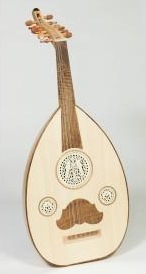What is an oud?

Similar to the lute in appearance, the oud is an 11 or 13 string pear shaped wooden instrument. It has double strings usually down to the lowest string, which will be single. Unlike the lute, the oud does not have any frets and it has a thinner neck. ‘Oud’ literally means ‘from wood’ in Arabic. The instrument is played primarily in West Asian and North African countries such as Egypt, Syria, Israel, Sudan, Palestine, Lebanon, Iraq, Kurdistan, Somalia, Yemen, Arabia and Iran, among other places.
Origins of the oud
The earliest description that we have of the oud comes from 9th century Arabic philosopher Yaʻqūb ibn Isḥāq al-Kindī. Its earliest form is thought only to have had 4 strings, and then over the course of its development, it became larger and more complex. But, in terms of the oud’s close relatives, musicologists have traced the lute family instruments all the way back to 3000BC.
The sound
In many Arab cultures especially, the oud is considered to be one of the central musical instruments. The beautiful sound of the oud is produced by its hollow body vibrating as the strings are strummed. It is a sound that is bound up with much canonical music throughout the ages, and is still an important part of many people’s musical lives today.
Here's a short video by Arab Instruments of what an oud sounds like.
How to tune the oud
As you would expect for an instrument with so many strings, tuning the oud can be quite an involved job. One of the added elements to consider is also that there are two prominent tuning methods for the oud: the Turkish method and the Arabic method. If you are playing music of Arabic origin, then it makes sense to adopt the Arabic tuning. For Turkish, Armenian or Greek music, the Turkish tuning will be the best for you.
Essentially, with Turkish tuning, everything is simply one step higher compared to Arabic tuning. This means that if a string on the oud tuned in the Arab tradition is pitched to be a C, the Turkish tuned instrument has that string as a D. On the highest four strings, for both the Arab and Turkish style, they are tuned in fourths.
The two bass string courses are tuned in a variety of ways, but the most common in Arabic tuning is C, F, A, d, g, c, with the most common in Turkish tuning being C#, F#, B, e, a, d. But this is just an overview of some of the common tunings; the main thing with all of this is to make sure that you have authentic strings which suit your instrument – consult an oud maker to check that this is the case.
How to play the oud
Learning to play the oud will be a long a potentially very difficult process, but not one without reward. The first thing that you need to is pick up the oud to get used to how it feels. If you are looking to buy an oud be sure to take a look at our selection at the London Guitar Studio.
The other thing that you will need to be getting used to is plucking the oud with a Risha, which is the plectrum that you must use. Navid from Oud for Guitarists shows you how to hold a Risha is 10 different ways.
Then, when you are getting a little bit more accustomed to the general feel of the oud, you will want to start getting stuck in with some scales. With an oud which is tuned in the Arabic way, the C major scale will be the easiest one to tackle. With the Turkish tuning, D major will be the first one to try.
You will then want to start slowly piecing together some of the more testing scales. At this stage, you should think about seeking out a teacher with experience to guide you. Alternatively, there are some useful DVDs and guidebooks to give you a helping hand. But, as with any instrument, practice makes perfect, so it’ll be a case of simply putting in the hours and making small but significant steps along the way.
Take a look at this video below by Oud for Guitarists which shows you how to play a basic jurjunah rhythm on the oud to help you get started.
Browse through our music material for more inspirational pieces including Habichuela - The Great Flamenco Guitars Of Today Vol. 2 and Paco De Lucia Almoraima.
